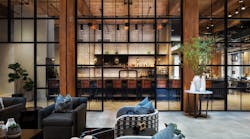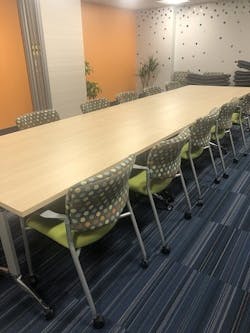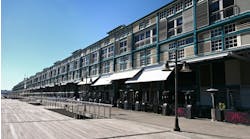As the coronavirus pandemic remains steadfast and consumers settle into their own personal definitions of a “safe” lifestyle, masters of the built environment are continually trying to find ways to help them get there. And such efforts can look quite different not just by market, but by need of the end user.
When it comes to interior surfaces and products, “clean” can be in the eye of the beholder. Sometimes perception is everything, as DLR Group’s Danielle Farchmin will explain below. And as we touched upon in our last issue’s Interiors column about antimicrobials, just because something is a disinfectant by the nature of its surface or composition doesn’t make it healthy, safe or even sustainable (by many people’s standards).
“Over the past 22 months of this pandemic, we have learned a lot. At the start, no one knew how the virus was transmitted, and we responded by excessively cleaning and sanitizing all surfaces,” said Lynne Willis, assistant director of the Association for Contract Textiles (ACT).
And that ideal did not hold strong, added Staci Patton, hospitality leader and principal with DLR Group. “We aren’t getting a lot of requests for materials that can be blasted to be disinfected, but rather those that are durable and can help cleaning teams by always appearing fresh,” she explained, adding that labor shortages are taking a toll on cleaning schedules.
While ACT has not issued any new COVID-related guidance when it comes to product maintenance in relation to cleaning, many members (such as the Mitchell Group) have adhered to the ACT Test Method 1-2020: Assessing Resistance to Liquid Cleaners, Sanitizers, and Disinfectants.
“Many ACT member companies maintained a detailed list of these test results—a great resource for facility managers when selecting cleaning, sanitizing and disinfecting products for use in their facilities,” said Willis. “When cleaning, sanitizing and disinfecting, it is important to follow the chemical product manufacturer’s directions including dilution ratios and any recommended rinsing or wiping after use.”
Some say that today the focus should be more on proper air filtration and purification rather than sanitizing of surfaces in combating the coronavirus, as well as integrating tech with more voice recognition capabilities and Nanotouch surfaces that utilize light to self-clean. So, with no one way to slay here, we spoke with three commercial specialists about where certain sectors are at when it comes to providing clean, safe interiors—and what that means to their respective clients.
[Related: Return to Work: The New Ways Companies Are Investing in Health and Wellness]
Office
Stacey P. Groder, president, A.M.P. Business Interiors, Inc.
Dealership
I can’t say our clients have decided to reupholster, but manufacturers have been really good about educating on how to clean the surfaces they have. We give every client a cleaning and use guide. For example, if you’ve got laminate, this is how you should clean it; if you’ve got vinyl, this is how you should clean it; these are the surfaces that are bleach-cleanable. With some hospital-grade cleaners they will degrade your vinyl if you just spray them on and leave them there. Here’s an excerpt from it:
Vinyl upholstery is the office workhorse because it is easily cleaned but regular use of harsh, bleach-type products can degrade the material. Make sure any cleaning solution you use is recommended for the materials in your office. Bleach needs to be part of a diluted solution that's left on vinyl upholstery or furniture for one minute and then rinsed. Hydrogen peroxide solutions of 1-3% can also be effective, as can alcohol-based solutions which contain 70% or more alcohol.
Corporate clients are changing how the office functions and how much they are putting in or where they’re putting it. Instead of a 6-foot by 8-foot workstation, they’re going with 8-foot by 8-foot so there’s more space between people when they are in the office. They are spreading them out and making them larger.
Air filtration has been one of the biggest, most consistent changes we’ve seen, whether clients are looking at updating their HVAC systems or installing more individual air purification units. We work with two manufacturers specifically—one that makes a smaller unit called CleanZonez that are about the size of a briefcase and can fit on a desk or workstation. It can also be wall-mounted and covers up to 100 square feet. The larger units we buy are through Trendway, called the AeraMaxPro, and while we wall-mount them there’s also a stand option. The medium covers up to 600 square feet and the larger model covers up to 1,000. So, clients are putting those in larger conference rooms and waiting areas and they provide multiple layers of air filtration and UV sterilization.
We have seen a push back against the use of plexiglass. In the beginning customers were putting it up but now there’s a lot of literature out there stating that, at least in the case of an airborne virus, plexiglass doesn’t do much except bounce the air right back at you.
[Related: Top 6 Trends Emerging From the Pandemic and What They Mean for Office Design]
Healthcare
Jim Blesius, director of marketing in charge of in-house testing, The Mitchell Group
Manufacturer
For fabric manufacturers, the challenge has been (even prior to COVID) creating products that will stand up to the constant use of disinfectants without having to rinse. In healthcare at least, most of the types of fabrics specified already have very good performance because most have a stain-resistant finish which will oftentimes be a barrier or protectant against the chemicals.
All the coated fabrics we sell into healthcare already have a stain-resistant finish. The real challenge, though, is that even coated fabrics with a finish might have issues over years with buildup. It could be a problem not just for the fabric itself, but it can also affect the product aesthetically.
We’re cognizant of that, and we began doing a lot of internal, accelerated testing on our product and at the same time we were contacted by Clorox for the same reason, but they were coming at it from the other side. They wanted to see how their products would work with coated fabrics—they understand cleaning crews don’t have time to do that without rinsing.
They ended up testing five of our commercial brands for about a year and a half using a modified ACT test, extending it to seven days and examining the product at the molecular level to see if any changes occurred, and all our products passed.
There are certain patterns, though, with deep embossings that we wouldn’t necessarily advocate for a healthcare setting because disinfectants can sit within those crevices. So, we just introduced seven new Sta-Kleen Silicone digital prints that not only combat that but are also environmentally friendly. The silicone is coated on a polyester double-knit back and the manufacturing process does not use any solvents and very little water. No VOC pollutants are released into the air and the water used in production is recycled.
We also always encourage rinsing in between cleanings if possible.
Hospitality
Danielle Farchmin, senior interior designer and senior associate, DLR Group
Design Firm
Hospitality is a separate beast when it comes to guest expectations, and it especially was during those peak (pandemic) times. The owners wanted the guests to feel comfortable, so it was about heightened communication, and we saw that all over. For instance, one hotel brand would place a sticker on the hotel room door frame and before you entered you had to “break” that seal, which told guests “We hear your concerns, they are valid and here’s our guarantee that the cleaning staff has been here and no one else since this sticker was placed.”
But today, the big thing we’re hearing from clients is they want to design flexible solutions that allow us to provide an environment that fosters community while allowing people to remain socially distant if desired. We’ll make sure furniture pieces are lightweight and mobile so they can go from a place setting of two to five in a lounge setting.
More immediately, we got some calls in from clients who wanted to retrofit the check-in desk because you get more intimate, one-to-one connections there. So there needs to be a barrier like plexiglass that allows you to feel you can still get service but with that element of separation still there.
Most importantly here though, DLR Group signed the AIA Architecture & Design Materials Pledge last year that outlined a commitment to specifying products in our projects that promote health and wellbeing for the users and the environment. This led us to embarking on our own Healthy Materials Initiative as a firm. We’re going through our libraries, starting with big ticket items that are high impact like flooring, wall finishes, ceilings and omitting materials with Red List chemicals as identified by the International Living Future Institute (ILFI).
We also need to think about the behavioral implications of our design. Carpet in a guest room can be perceived as a place where germs and bacteria can fester and grow, so that’s why a client might lean toward resilient flooring, which we are trying not to specify as its composition can fall under PVC vinyl, which is hazardous to both the environment and human health.
So, what are your other options? There are tiles, there’s hardwood, and are they the same cost? No. But it’s a little give and take. It’s about understanding what a user might perceive as “clean.”




